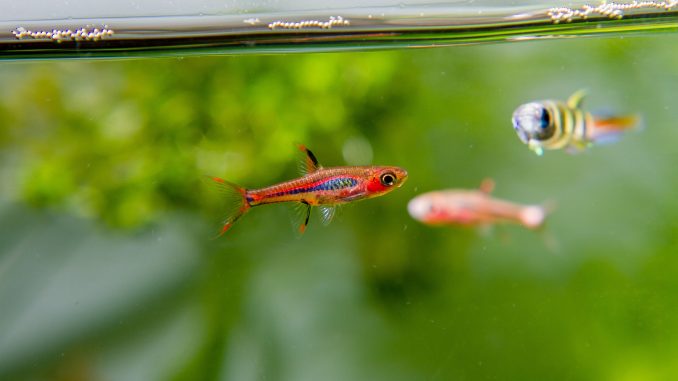
Chili rasboras are beautiful and tiny schooling rasboras that are great in a nano tank or as part of a larger community tank. When in their school, they are super fun to watch and have great personalities.
One of the fun things about the Chili Rasboras is that they are super active, bringing life to your aquarium. They are also colorful and stand out, providing a stunning aesthetic for your community aquarium. In a stand-alone tank, it’s all Chili all the time, and they’ll put on a colorful show that will keep you entertained all day.
Another bonus of adding them to a community tank is that they are super peaceful and get along well with other fish, as well as invertebrates (well, the peaceful ones).
Read on for care tips, history, and everything you need to know about providing optimal conditions for these fascinating schooling fish.
TABLE OF CONTENTS
Chili Rasbora Facts & Overview
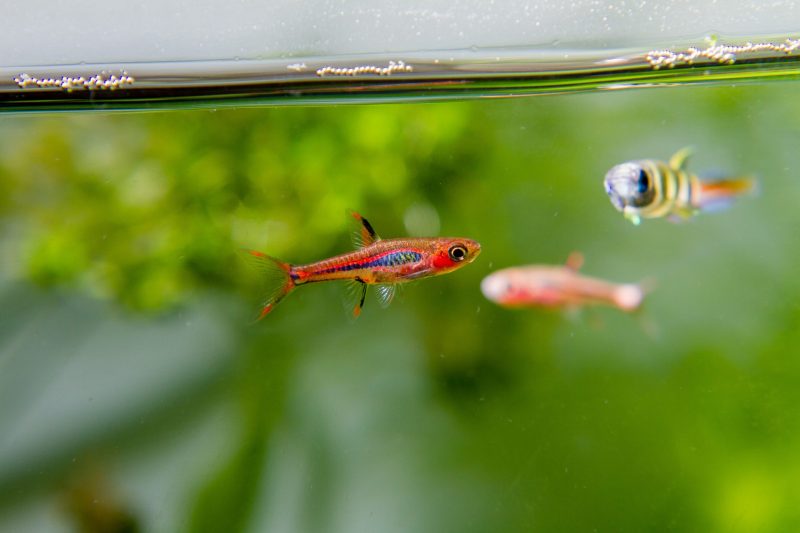
| Category | Rating |
| Care Level: | Moderate |
| Temperament: | Peaceful |
| Color: | Red and black |
| Lifespan: | 4-5 years |
| Size: | .6-.8 inch |
| Diet: | Omnivore/Micropredator |
| Family: | Characidae |
| Minimum Tank Size: | 6-8 gallons for a school of 8-10 |
| Tank Setup: | Densely planted freshwater |
| Compatibility: | Peaceful community |
The Chili Rasbora (scientific name Boraras brigittae) is just a gorgeous nano fish that swims and plays happily in schools. Not only are they attractive fish, but they have stellar personalities. They really have all the positives in a tiny package.
Native to Indonesia’s Southwestern Borneo, Chili Rasbora, also known as the Mosquito Rasbora, is one of the smallest tropical fish found in home aquariums. The males are known for their bright ruby red color (when they are properly cared for.)
Originally described by Dieter Vogt in 1973, the Chili Rasbora is named Rasbora brigittae after Dieter’s wife, Brigitte. The Chili Rasbora is not a true Rasbora and in 1993 was put in the Boraras genus.
The alter ego moniker Mosquito Rasbora comes from the Chili Rasbora’s natural habitat, which is loaded with mosquitos.
Although there are a number of Boraras species that are popular in the aquarium trade, Chili Rasboras are the favorite of hobbyists because they are so beautiful to look at.
Typical Behavior
Occupying the top and middle of the aquarium water column, Chili Rasbora is easy to spot despite its small size. And although they prefer the top and middle, don’t be surprised if you see them swimming and eating at the middle and bottom levels.
When they get together as a school, they are unpredictable, yet never boring to watch. They are very peaceful fish and get along with other peaceful fish and invertebrates.
You should make sure you have a tight-fitting lid on your aquarium. Although Chili Rasboras are not known for jumping, they do sometimes try to leap out of the tank, and they’re so small, you run the risk of losing them.
Appearance
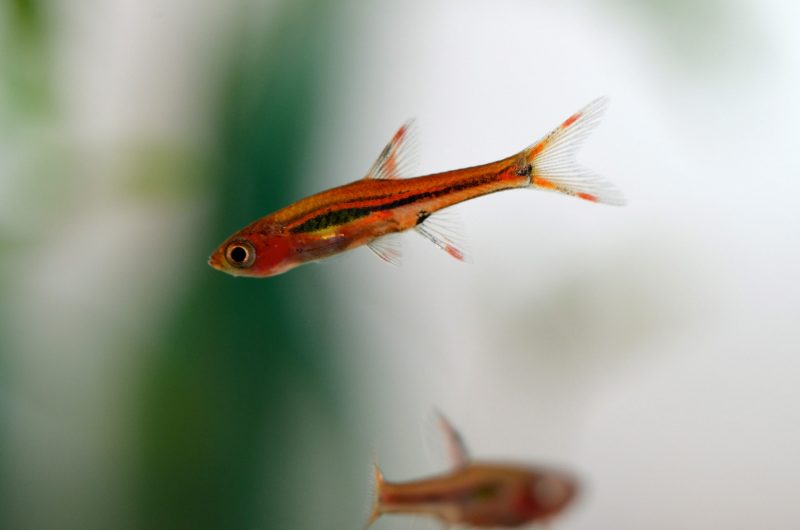
Gorgeous creatures, Chili Rasbora have a dark stripe along the side of their red bodies. This dark stripe is contrasted with a deep red stripe above the dark one.
They also have small dark spots at the base of the anal and tail fins.
Male Chili Rasbora can be distinguished from females by looking at dorsal and anal fins, which have vivid red stripes.
At ¾ of an inch (18mm), these beauties are truly nano fish.
Habitat and Tank Conditions
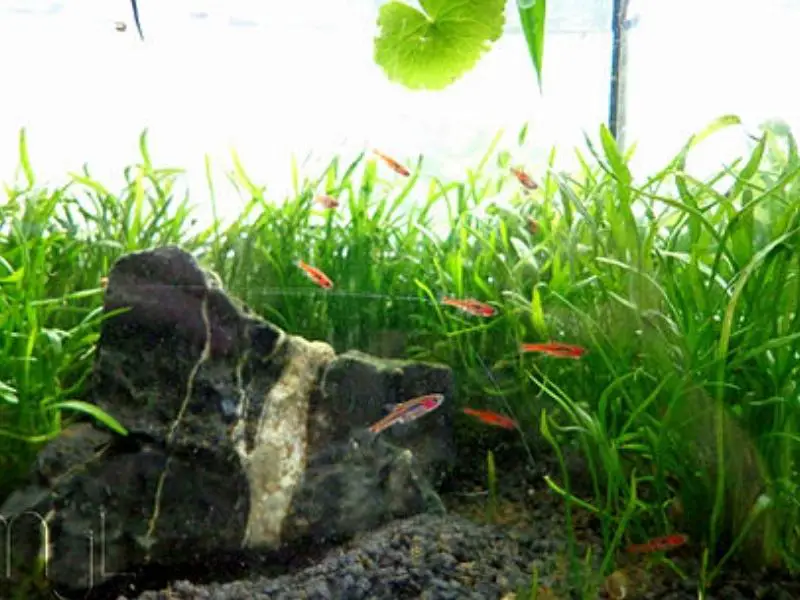
To enjoy the best color possible, make sure you provide your Chili Rasboras with a planted aquarium with floating plants and a dark substrate. Fine texture sand or gravel is ideal for the nano Chili Rasboras.
These conditions will also encourage the best health for these tiny fish.
In their natural environment in Borneo, they make their home in blackwater streams and pools, so the dark substrate will meet their inclination for the dark bottom.
Their natural habitat also includes soft water with a low pH, so they will need that in your home aquarium, too.
They will appreciate a lush environment that has both planted and floating plants. Roots and branches mimic their environment and hanging vegetation limits the direct light to the Chili Rasboras.
Although you can keep them as a smaller school of six in a 10-gallon nano tank, if you keep them in a larger tank, you will have enough room for a huge and stunning school, which will produce a moving light show in your aquarium.
If you include live plants in your tank set up, they will not only have a blanket to explore, but the floating plants will also make a home for plankton and worms, which are just the right sized snack for tiny Chili Rasbora mouths.
The plant cover, as we mentioned, will dim the light in the tank, which encourages the development of more intense and vivid colors.
Water Conditions
Chili Rasbora’s natural environment has a slow flow of water, so you should create the same water conditions in your home tank. These fish are extremely small and they will not be able to handle a strong current.
To counteract any current that would be too strong, add branches, driftwood, logs, and other decorations to break up the current. Also, the plants will help with the current, too.
They do need a filter because they require pristine water in order to survive; just make sure the filter is not too strong. Because they are so small, any change in water condition could be fatal, so you need to monitor and maintain stable parameters.
In addition to a slow current, Chili Rasboras prefer water that is both soft and acidic. You’ll need a test kit to monitor levels, and you could use distilled water or reverse osmosis to dilute tap water to create the proper conditions.
If you need to lower the pH level, there are natural remedies that can be used instead of additives These include peat (moss or pellets), and almond leaves–these natural additions will release tannins that in turn reduce the pH.
Pro tip: The presence of tannins and the low pH it provides is beneficial for the Chili Rasbora’s health, reducing pathogens in the water and making sure they don’t get sick.
The optimal parameters to ensure a close match to their natural habitat are:
- GH: 1-2
- KH: 3-12 dKH
- pH: 4.0-7.0
- Temperature: 68-82.4° F (20°-28° C)
Although Chili Rasboras have this wide acceptable temperature parameter, they do require the stability we talked about, so be sure to maintain a constant temperature.
For this reason, don’t be fooled by the low end of the temperature range and think that you don’t need a heater. Variations in room temperature can lead to variations in tank water temperature, and chilly water creates stress to fish. Stressful fish have compromised health, lifespan, coloration, and mood.
Set the heater to a point on the acceptable range of 68-82.4° F (20°-28° C) and maintain it for happy, healthy, and stress-free Chili Rasboras.
In addition to maintaining a temperature that is not too cold, you also want to make sure that the temperature is not too hot–Chili Rasboras can easily be overheated by long periods of direct sunlight (another reason that the plant cover is beneficial for these nano fish.)
Water conditioner
The tap water supply has chlorine and other additives to keep it clean, but these additives are toxic to fish, so you should always use a water softener designed for aquariums.
What Size Aquarium Do They Need?
A 10-gallon nano tank will house a small school of 6 Chili Rasbora. If you want a larger school, or if they are joining a community aquarium, you will need a larger tank. Keep in mind that although these nano fish prefer a dense habitat, they also need room to swim.
How Many Can Be Kept Per Gallon?
You want to make sure the Chili Rasbora is kept in a school of at least six. Fewer than that and they will not be happy — they are meant to be together. You can house two Chili Rasbora per gallon, so six fish would be acceptable for a 10-gallon tank.
Tank Mates
The Chili Rasbora is a super chill fish and will get along with other peaceful, smaller fish. It also does well with smaller invertebrates like dwarf shrimp. Stay away from aggressive and larger fish that will both steal their food and make them food.
Suitable Tank Mates for Chili Rasbora
- Amano Shrimp
- Celestial Pearl Danios
- Cherry Shrimp
- Chocolate Gourami
- Cory Cats
- Neons
- Sparkling Gourami
- Wood Shrimp
Keeping Chili Rasbora Together
As for schooling fish, Chili Rasbora has to stay together. The minimum number for a school is six Chili Rasbora. However, they will be much happier (and also more fun to watch) if they are in larger schools of 20 or more fish.
Diet
Although they are omnivores, Chili Rasboras prefer a carnivorous diet. Offer them a variety of flakes, pellets, and freeze-dried, fresh, or frozen protein sources like bloodworms and chopped micro worms.
To ensure the best color and health of your Chili Rasbora, make sure you give them varied sources of nutrition. Be mindful not to overfeed these fish–they are very small and can get sick if they eat too much, and also the more they eat, the more waste they create, which can dirty the water and make them sick.
One final thing to remember is that due to their nano size, they need all food chopped and pulverized. Flakes, for example, should be crushed to powder form.
Care
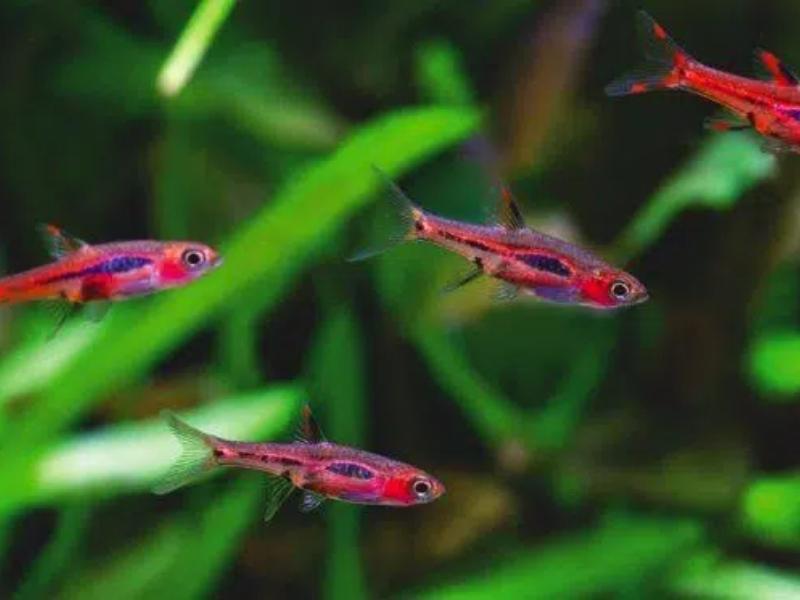
It is very important to keep Chili Rasbora’s tank impeccably clean. You should clean the substrate and perform partial water changes regularly.
They are strong fish, but they are very small and they are very sensitive to changes in water conditions, and cannot tolerate a dirty tank.
They are prone to illness and disease if their tank is not properly cared for. Conditions that could afflict your Chili Rasbora include fungal infections, bacterial infections, and parasites, like Ich. You should quarantine sick fish and treat them with Ich medicine or other over the counter medications that you can find at fish and aquarium stores.
You might also find physical manifestations of stress on their tiny bodies, poor water quality or parameters, or spoiled food)
Common symptoms that indicate that your fish is ill include the following:
- Bloating
- Bloody streaks (Ich)
- Discolored Scales
- Fuzzy cotton-like growths
- Grey spots
- Lesions
- Pimples (Ich)
- Pop eye
- Red streaks
- Red ulcers
- Scratching (Ich)
Breeding
When they are ready to breed, the male Chili Rasboras turn a brighter red, so you can tell them apart from the female. In addition, the black and red markings on their dorsal and tail fins become darker.
Females, on the other hand, will look rounder and plump because they are carrying eggs.
Pro tip: Watch out because the male Chili Rasboras can get a little territorial at breeding time, and they may fight, so you need to make sure that you have enough space for them to each have their own little area.
You may see the male Nanos showing off to get the female’s attention. If he gets it, the female will lay a small number of eggs that she scatters on the tank’s bottom.
And that is where the parenting ends. Neither the male nor the female Chili Rasbora actively care for their eggs at all. In fact, they have been known to cannibalize their own eggs.
If your home aquarium is dense enough, the fry may have enough cover to survive despite the threat of other fish in the tank having them for a midnight snack (never mind their own parents!) However, if you are hoping to breed the Chili Rasboras in earnest, you should set up a separate breeding tank.
They spawn pretty constantly, so in a separate breeding tank, you have the chance to give the fry a fighting chance to live. You can feed the fry infusoria and paramecium until they can handle larger foods.
To create the best balance for breeding, you will need 1 to 2 females for every male in the tank, and you’ll need males that are dominant.
The breeding tank setup should be as follows: Add small groups to spawning containers, with mesh at the bottom that is large enough that the eggs can fall through but small enough that the parents cannot access the eggs and eat them.
It’s kind of fun to see them spawning–they look like they are chasing each other around the tank. The male and female Chili Rasbora can be kept in the breeding tank for three or four days and then they should be moved back to the main tank.
If you leave them in the breeding tank for longer than that, the Chili Rasbora fry are at risk.
Remember that Chili Rasbora is especially sensitive to water changes, so if you are using a breeding tank, you must make sure that the temperature, slow, pH, and hardness is consistent in both tanks; otherwise, you are likely to lose the fish in the transfer as they can not tolerate the instability.
Are Chili Rasbora Suitable for your Aquarium?
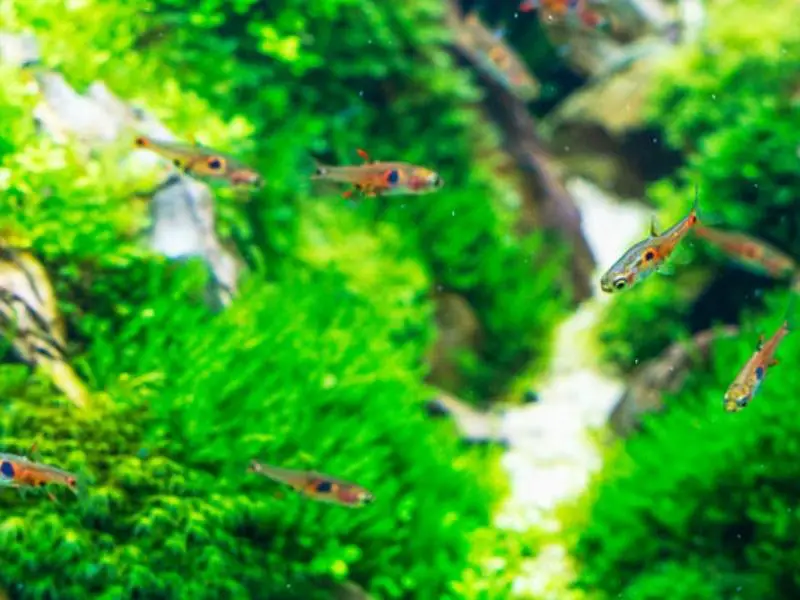
The Chili Rasbora is a lot of fish in a small package. They are gentle and shy; they are beautiful to look at with their vibrant colors and playful schooling antics, and they get along well with other small and peaceful fish.
You’ll enjoy them whether they are in their own dedicated tank or a colorful splash in a larger aquarium.
Are Chili Rasbora your favorite tropical fish? Let us know why in the comments below…
FAQ
Q: Why do Chili Rasbora need so many plants in the tank?
A: There are a number of reasons that Chili Rasbora appreciate lush vegetation that includes both planted and floating plants. It mimics their natural habitat in Indonesia, giving them hiding places and providing them with nutrition from microscopic creatures that collect on the leaves of the plants.
The lush plants also filter light so that the Chili Rasbora is not overexposed to heat and light (actually, the best color vibrancy comes with lower lighting.)
Additionally, when they are swimming with their school, they enjoy swimming through plentiful aquatic plant life. They also like exploring under the plant ceiling.
Q: Should I keep more than one Chili Rasbora in my home aquarium?
A: Absolutely! Chili Rasbora is a schooling fish and we don’t recommend having fewer than six in a tank. They are designed to be together, so if you strand one or two (or anything less than six, really), you are going to have unhappy fish that are stressed out.
Being around their own kind brings them stability and security, and also gives them a chance to swim together, which is so important for these active little nano fish. If you keep fewer than six Chili Rasbora together, you will definitely see the change in their mood and temperament, but you will also see that their colors are less vibrant and that they get sick more easily.
In fact, we would recommend getting a tank larger than five gallons so that you can keep a school of at least 20 and maybe even more than that.

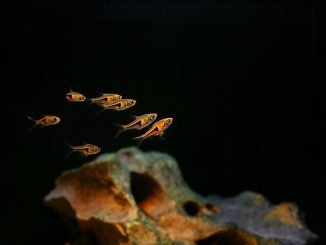
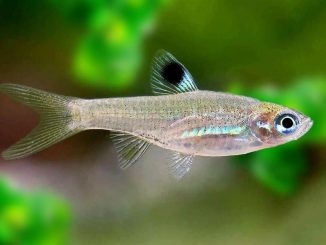
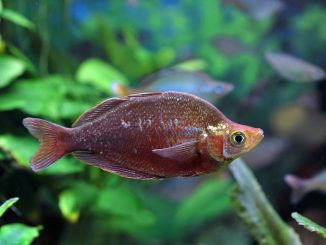
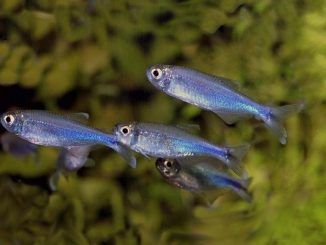
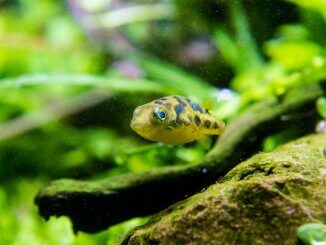
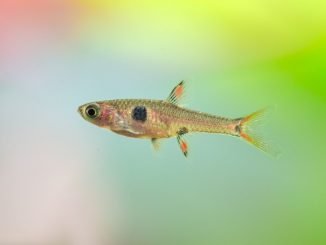
I have a seven gallon aquarium.
I would like to keep chilli rasboras with cherry shrimp but I don’t know if that’s possible in a 7 gal?
Would it be bad if the temperature is constantly at 18°C?
Yes 18C would be much too cold for them. In addition to recommendations on this page, other pages recommend a temperature no lower than 28C.
A small school of chili rasboras should be fine with cherry shrimp. They may or may not eat freshly hatched shrimplets, but the adult shrimp will be safe, and bigger than your Chilis.
Can I keep 6 of these guys in a 5g with a Nerite Snail?
Thanks for the article. I have been keeping Guppy fish for around six months. I imagine Chili Rasboras may be a nice addition to my tank. First I have to adjust the lighting, and water conditions.
Can I put 6 chili rasboras in a 10 gal that already has a zipper loach, a dwarf gourami, and a nerite snail? Or would that be too much? I have a decent number of plants and a filter that hangs on the back of the tank.
Hi,
what is the 5G minimum recommendation based on seeing that other sources recommend at least 10G due to their high activity level? I keep Least Rasbora myself in 15G+ which are an even smaller Boraras species and 5G seems to be very inadequate and way too small. It’s clear why shop sites do advertise them for 5G but reputable sources should not follow suit here. I really would like to see this recommendation be bumped up to 10G here. At the very end of the article you recommend to get a larger than 5G tank yourself.
All in all a good article with a lot of information, some inaccuracies here and there. The biggest certainly is that two of the four photos show Least Rasbora, not Chili Rasbora.
Thanks!
This article shows 2 Least Rasbora photos and 1 photo of a malnourished (juvenile) Chili Rasbora..
Care level easy is not correct.
Lifespan is not to be expected at all.
5 Gallon is inappropriate to the species.
Hello RivEben,
Thank you for pointing out these discrepancies. I’ve added some additional information and updated the photos.
-Robert
Robert, I agree with the previous statements that 5 Gallons is not enough and this should be rectified. Why perpetuate clearly bad practice. To share a quote from another source:
“Unfortunately, many people think that just because these fish are small they can be put in a small aquarium. This is simply not true. To give the best chili rasbora care possible, your school of fish will need at least 10 gallons (37.8 L) with a group of at least 8 or more of the same species. […] But what if you have an aquarium that is 5 gallons (18.9 L) […]? While many hobbyists make beautiful planted aquarium setups featuring chili rasboras, the answer is no.”
Mosquito Rasbora are very active, form territories and should absolutely not be recommended for 5 Gallons. Speaking with a lot of experience. I hope this information is updated!
Andrej
Hi Andrej, Thank you for your advice and comment. I agree that rasboras need more space to swim around. I’ve updated the article to reflect this.